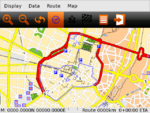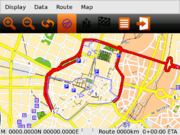Navit
From Openmoko
Navit is one of the applications that runs on the Openmoko Phones. For a list of all applications, visit Applications
As described on the Navit home page,
"Navit is a car navigation system with routing engine.
Its modular design is capable of using vector maps of various formats for routing and rendering of the displayed map. It's even possible to use multiple maps at a time.
The GTK+ or SDL user interfaces are designed to work well with touch screen displays. Points of Interest of various formats are displayed on the map.
The current vehicle position is either read from gpsd or directly from NMEA GPS sensors."
Some people say Navit is also a good choice for pedestrian and bicycle navigation.
Contents |
Acknowledgment
Thanks to Alessandro, stefan_schmidt, cp15 and all Navit developers I have done a small ("not really working") preview of Navit on Neo1973 at Telemobility Forum 2007. Thanks to GFoss guys to invite me. Tyrael
I got navit set up and configured to the point where it follows me on the map. It doesn't have street names or any other information, just the map and the cursor showing the location and direction. Here's what I did:
- Install navit ipkg on NEO (because of a bug in opkg it's necessary to wget then install, instead of pointing opkg at the URL):
wget http://www.acoveo.org/navit_0.1.0+svnrev1255-r0_armv4t.ipk opkg install --force-depends navit_0.1.0+svnrev1255-r0_armv4t.ipk
This package includes a patch to navit which improves map panning speeds.
- Or roll your own from svn using the toolchain (having checked out trunk in the navit directory, and assuming you have written navit_control):
. /usr/local/openmoko/arm/setup-env om-conf navit --disable-samplemap om-make-ipkg navit navit_control
You may want to apply the map panning patch from acoveo: http://www.acoveo.org/openmoko/font_scaling_patch.diff
Set up the maps you want
The Easy Way
Use Navit pre-processed OSM maps. Navigate to the region you want, and click select to select it, select the region you want, then click download
If you just want the entire planet (as of this writing, ~1.6 GB), it's here.
CloudMade also has up-to-date maps from OpenStreetMap by country (by state in the US).
From the command line
- Openstreetmap - follow directions at http://wiki.navit-project.org/index.php/OpenStreetMaps
- There are some up-to-date maps already prepared, e.g.:
- Openstreetmap - follow directions at http://wiki.navit-project.org/index.php/OpenStreetMaps
wget -O germany.bin http://maps.navit-project.org/api/map/?bbox=5.185546875,46.845703125,15.46875,55.634765625
- Here's an example of what I did to get the maps for the area around Seattle, Wa where I live:
- figured out map coordinates using http://informationfreeway.org/?lat=47.520270037501454&lon=-122.20130713167327&zoom=9&layers=B000F000
- Downloaded 4 regions from openstreetmaps (see below for a script to do this for you automatically for largish areas)
- Here's an example of what I did to get the maps for the area around Seattle, Wa where I live:
wget -O map1.osm http://www.openstreetmap.org/api/0.5/map?bbox=-122.2,47.5,-122,47.7 wget -O map2.osm http://www.openstreetmap.org/api/0.5/map?bbox=-122.4,47.5,-122.2,47.7 wget -O map3.osm http://www.openstreetmap.org/api/0.5/map?bbox=-122.4,47.3,-122.2,47.5 wget -O map4.osm http://www.openstreetmap.org/api/0.5/map?bbox=-122.2,47.3,-122,47.5
- Made a navit binary map file using the osm2navit binary that comes with the navit package on my linux box (it is also installing to the target from the .ipk)
cat *.osm | osm2navit --dedupe-ways mymap.bin
Copy the map to the NEO
scp mymap.bin root@neo:/home/root/card/map
- Change the navit.xml file on the NEO to use the new map
cp /usr/share/navit/navit.xml ~/.navit/navit.xml vi ~/.navit/navit.xml <map type="binfile" enabled="yes" data="/home/root/card/map/mymap.bin" />
- Run navit
- Start gllin (for GTA01)
- Start gpsd ( gpsd /tmp/nmeaNP )
- Start navit
- The version of osm2navit with which you build the maps should match the version of navit you have. If in doubt, build the maps on the Openmoko.
Something about the Internal GUI
Navit supports a "always center on vehicle" option.
To activate this add
follow="3"
to the vehicle tag in navit.xml. The "3" causes to give the gui time to do something between the repaints (drag the map or browse the menu). When its set to "1" navit does nothing more than repainting the map continuously.
News
Street names
They are now displayed on Openmoko using the CVS version of Navit (20071217).
Point selection by pen
Easier using the CVS version (20071217).
Route > Destination
The Route > Destination menu item crashes the software (20071217 and 0.04, but fixed in 0.1.0+svnrev1255).
A workaround is to set the LANG variable before calling navit. For example:
LANG=fr_FR.UTF-8 navit
Note that a short syntax (e.g. LANG=fr) would not work.
If you put an "export LANG=fr_FR.UTF-8" into your /etc/.profile file, it will automatically set this environment variable every time you boot up. This way, you can launch Navit from the Icon in Illume.
http://trac.navit-project.org/ticket/51
Speech
Navit can speak if you install eSpeak + speech-dispatcher and updates your navit.xml file.
For adventurous people, one way to do this:
- mokoTTS aims to integrate these packages in OM:
http://projects.openmoko.org/projects/mokotts/
install espeak, dotconf, and then speech-dispatcher. note: running 2008.8 updating from zecke's "testing" repo does not require "dotconf"
- change the speech tag in navit.xml:
<speech type="cmdline" data="spd-say '%s'" />
or "spd-say -l fr '%s'" for using the French voice for example.
Maps
Downloadable Maps
Downloadable OSM maps for most areas of the world are available free in Navit format from Cloudmade at http://downloads.cloudmade.com/. Simply navigate to the country or region you want and download the .navit.bin.zip version of the map. You'll have to exatract the .bin file from the ZIP archive before using it with Navit.
Script to download OSM maps
Wurp wrote a little python script to download all OSM maps within a lat/long rectangle. Just copy the script to a file called dlOSM.sh, chmod +x it, and run it like dlOSM.sh <minimum latitude> <maximum latitude> <minimum longitude> <maximum longitude>
It takes a long time for large maps. I could optimize it some by having it try to get a big section at once, then if it fails, break it into smaller pieces and recurse. I'm not sure when/if I'll get around to that...
dlOSM.sh:
#!/usr/bin/python
import os
import sys
#import math
def doIt(cmd):
os.system(cmd)
def getOsms(basename, minLat, maxLat, minLon, maxLon):
'''basename - base name of map, maps are named {basename}{count}.osm
minLat - latitude of the west side of the map
maxLat - latitude of the east side of the map
minLon - longitude of the north side of the map
maxLon - longitude of the south side of the map'''
wgetCmdTemplate = 'wget -O %s%s.osm http://api.openstreetmap.org/api/0.5/map?bbox=%s,%s,%s,%s'
currLat = minLat
mapCount = 0
while currLat < maxLat:
nextLat = min(currLat + 0.1, maxLat)
currLon = minLon
while currLon < maxLon:
nextLon = min(currLon + 0.1, maxLon)
doIt(wgetCmdTemplate % (basename, mapCount, currLon, currLat, nextLon, nextLat))
currLon = nextLon
mapCount = mapCount + 1
currLat = nextLat
(minLat, maxLat, minLon, maxLon) = map(float, sys.argv[1:])
getOsms('map', minLat, maxLat, minLon, maxLon)
 |
Navit
Navit is a car navigation system with routing engine.
|

